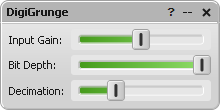| AudioMulch Help > Contraption Reference > Effects | Previous Next |
DigiGrunge
Applies digital distortion effects (bit depth reduction, sample rate decimation).

DigiGrunge can be used to create digital distortion and extremely clipped and distorted sounds characteristic of low bit rate sampling techniques. With DigiGrunge you can apply two types of digital distortion to a sound: bit depth quantization noise and sample rate decimation aliasing.
 |
See the Adjusting Contraption Properties section for information about using sliders, knobs, presets etc. |
Related Contraptions
Parameters

|
Input Gain (InputGain) |
Adjusts the input signal to achieve an optimal amount of quantization noise. This is important as the bit depth quantization technique employed in this contraption is dependent on the input level. |
|
Bit Depth (BitDepth) |
Controls the number of bits being used to represent the signal. |
|
Decimation |
Controls the amount of effective sample rate reduction. A decimation setting of 1 keeps the signal at its original sampling rate, a decimation setting of 2 reduces the sample rate to half the original, and so on. Use Decimation to add digital distortion to the sound. |
Relevant Example Files
The following files provide some examples of how DigiGrunge can be used:
GrungeDrumOne.amh & MulchJungle.amh
 |
To open the Example Files directory, go to the File menu, select Open, and double-click on the Examples folder. Read descriptions of the example files here. |
Suggested Uses and Practical Applications
Ross Bencina says: “Select a bit depth of 1 to create an extreme, clicking distortion. This reduces the signal to either on or off (plus a sign bit). The distorted signal can then be used as an input for resonant contraptions like 5Combs or Phaser to create sounds with a percussive quality.”
Also: “Use less extreme settings of bit depth to create the type of digital noise commonly associated with early digital samplers and computers.”
Technical Discussion
The Bit Depth control applies the process of quantization to reduce the number of bits (effectively, the range of numbers) used to represent the audio signal. At its most extreme, the signal is reduced to 1 bit – one of two values: 0 (off) and 1 (on), which produces extremely distorted clicking.
The Decimation control produces an effect called digital aliasing, which causes all frequencies in the input signal that are above half the effective sample rate (technically referred to as the Nyquist frequency) to be reflected around the Nyquist frequency. Therefore, as the Decimation parameter is increased, frequencies above the Nyquist frequency get reflected progressively lower below it, often resulting in low frequency tones and other artifacts.
| Previous Next |
